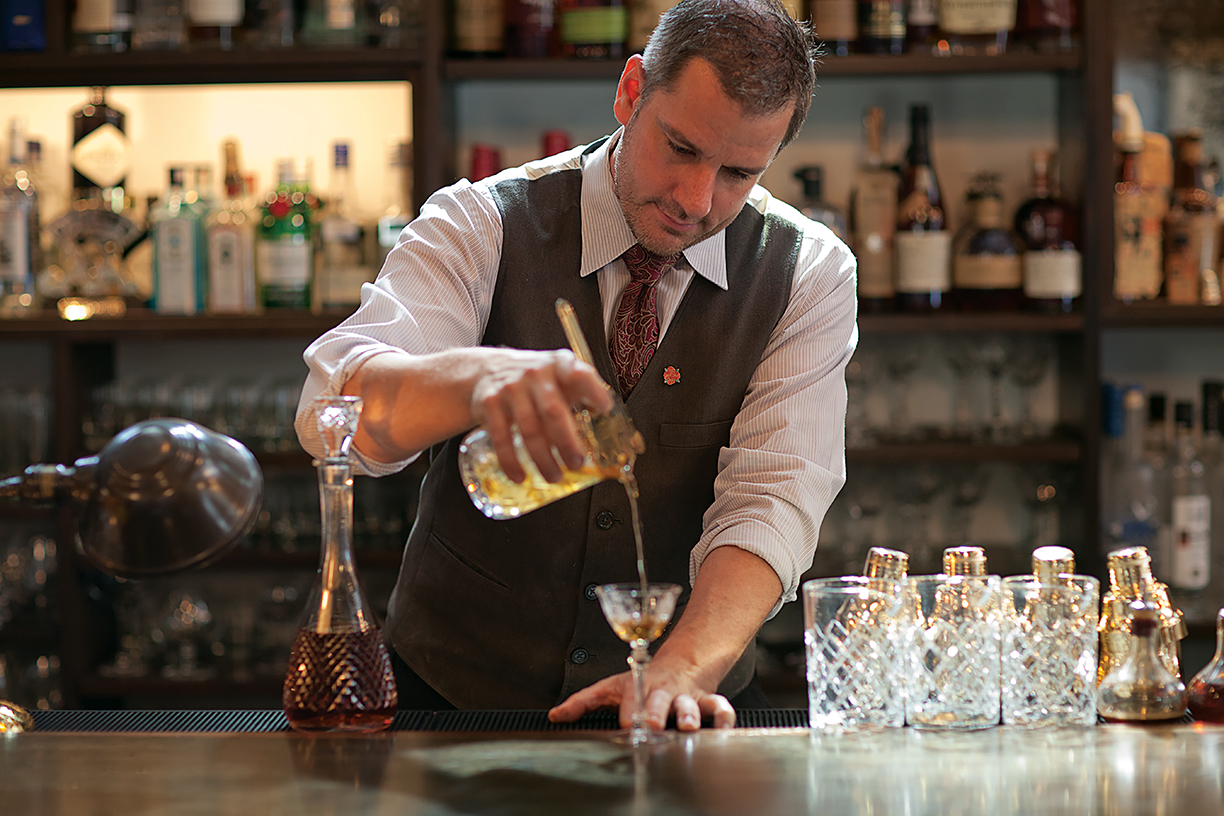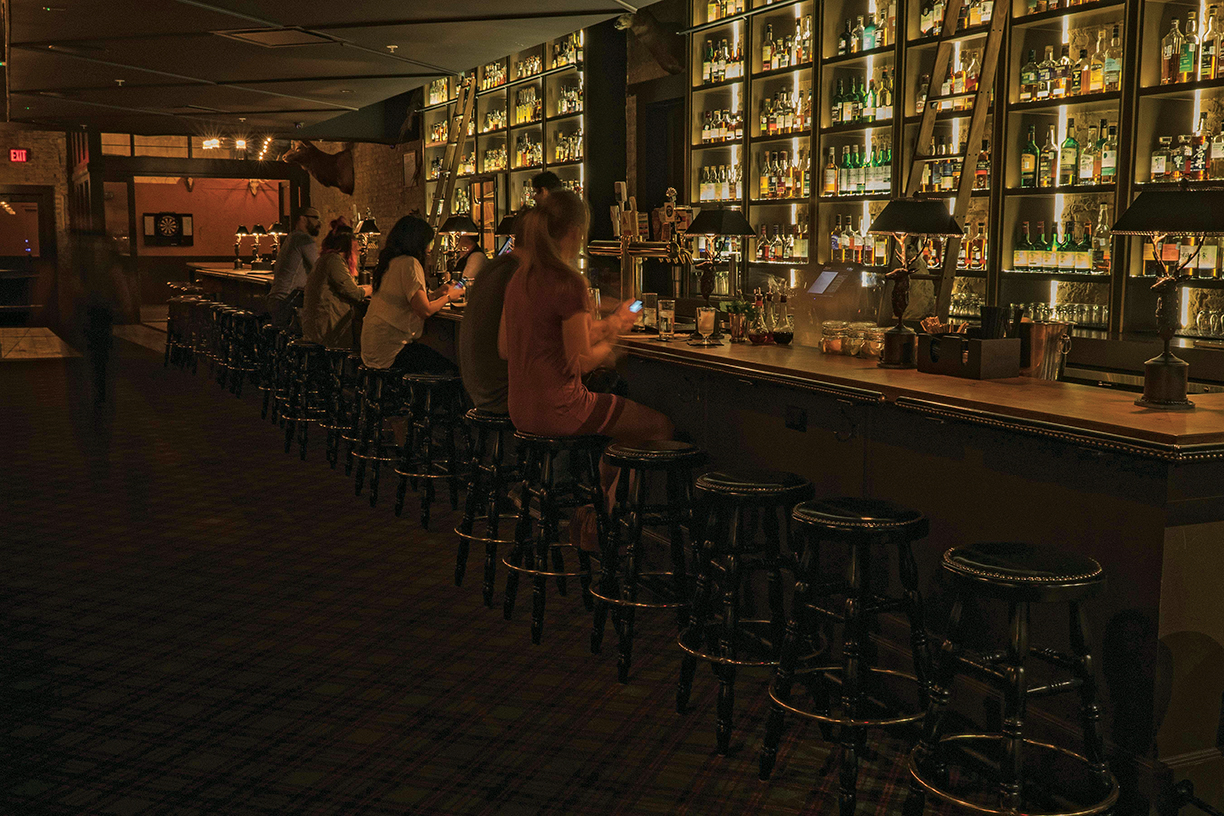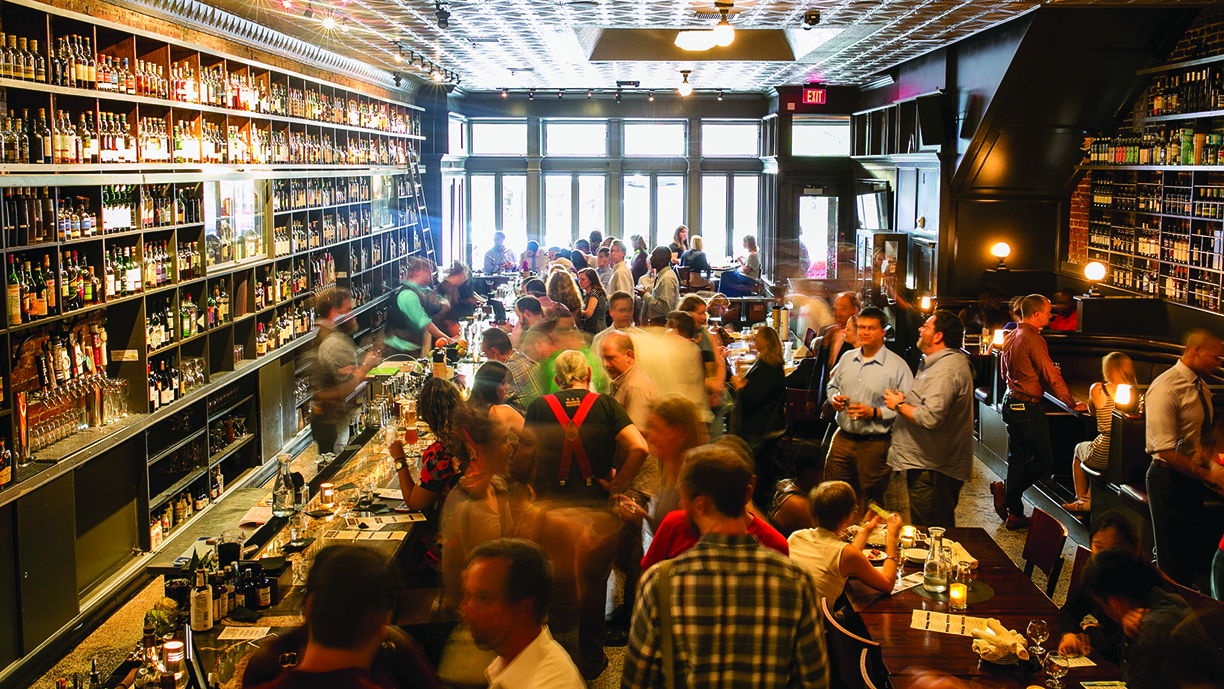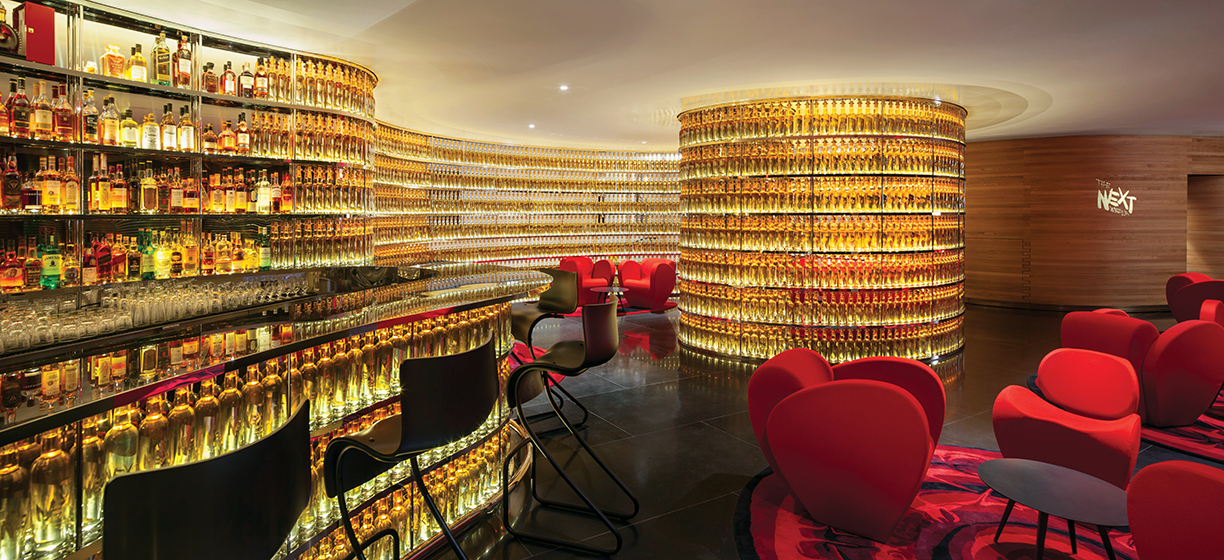
Is any spirit currently trendier than whiskey? Its popularity nationally is reflected in elaborate bars dedicated to its discovery.
The history of whiskey dates back to the 15th century and in America its popularity has endured every beverage trend from flavored martinis to craft beers. As Americans embrace this brown liquor — originally from Scotland but now produced from Bangalore to Brooklyn — as a timeless indulgence, they increasingly patronize high-end whiskey bars showcasing the spirit’s remarkable diversity. In Los Angeles, one of the bars that set the whiskey revolution in motion was Seven Grand and its success led to spinoff s in San Diego, Denver and Austin. Steve White, general manager of the downtown Austin location, reports a current selection of just under 600 whiskeys, but insists that sheer numbers are not what motivates him. “My goal is to have the most curated collection of whiskeys that our bartenders can be proud to put in front of anybody,” he explains.
In addition to rare and exotic varieties like a 21-year Hibiki from Japan or Balvenie Tun 1509 single malt from Scotland, Seven Grand offers Texas-crafted whiskeys, including Garrison Brothers Distillery not far from Austin. White reports that customers are eager to discover local brands — a prevailing trend throughout the food-and-beverage industry — and insists Balcones Dsitilling, another Lone Star State label, is competitive on the world stage. In the back of the original Seven Grand in L.A., an exclusive tasting library called Bar Jackalope pours particularly rare whiskeys and give s regulars an opportunity to rent lockers to store their own valuable hooch.
With its mounted game heads, antler chandeliers and two-story whiskey bar, illuminated in a soothing amber glow, Butcher and the Rye is a popular hangout in downtown Pittsburgh. Owned by classically trained chef Richard DeShantz, a restaurateur whose four establishments have helped fuel a hot food scene in the Stell City, Butcher and the Rye stocks 600-plus varieties of whiskey, including more than 350 bourbons. Meanwhile, the kitchen offers specialties like beef tartare with black garlic aioli and truffled egg, duck liver pâté with Sauternes gelée, panseared halibut, and buttermilk-fried rabbit.

Canon in Seattle boasts America’s largest spirit collection (4,000 labels and counting), with whiskeys consuming about 150 pages of the 191-page Captain’s List. “We have a very fiite amount of space and when it’s completely consumed that will be our number,” says proprietor Jamie Bourdreau of the lists’s upside potential.
Reluctant to express personal preferences, the Seattle whiskey authority quips, “Whenever someone asks me for my favorite it can usually be translated to, ‘What should I drink or order?'” Bourdreau explains, “The proper reason to that question, in my humble opinion, is: ‘What are you using the whiskey for, what time of day, time of year, what have you enjoyed in the past, and what’s your budget?”

Canon’s list includes many century-old whiskeys priced in the stratosphere, such as a 1898 Canoe Club ($1,225 per pour).
Cocktails — many are memorialized in “The Canon Cocktail Book” authored by Boudreau — include classics like Sazerac and Champs Élysées, multiple mules and creative originals. “I enjoy classics and their history, but have an equal passion for coming up with new combinations and presentation styles,” reports Boudreau, who in spite of his mixology expertise insists Canon is much more than a bar. His kitchen turns out inspired dishes like seared foie gras on pain perdu with cocoa nib “soil,” sweetbread nuggets with agrodolce and barbecue sauce, and duck cassoulet.
Las Vegas’ The Whisky Attic claims to maintain the greatest whiskey collection in America, and whether or not that is actually the case, this off-the-Strip venue is certainly one of the best places to learn about different styles and explore new labels. Various tastings are offered by appointment only, and whether a customer’s interests lean toward Kentucky, Scotland or Japan, the Attic’s approximately 1,800 bottles provide fertile grounds for discovery.
As politics is often enough to drive anybody to drink, it should be no surprise Washington, D.C. offers several outstanding whiskey bars. The Next Whiskey Bar is ensconced in the historic Watergate Hotel, part of the property’s recent $125 million renovation. The space features curvaceous floor-to-ceiling shelving displaying 2,500 custom-made whiskey bottles, all dramatically and sensually illuminated.
Among the selections at The Next are a 23-year Pappy Van Winkle ($500 per pour), 25-year Macallan ($300) and 18-year Yamazaki Mizunara 2017 ($650), all excellent options for lobbyists with unlimited expense accounts. But there are whiskeys for everybody at The Watergate’s chic watering hole. “We’re shaking off the ‘appeal to only older men’ mentality,” says the hotel’s assistant food-and-beverage director Chad Gentile, insisting whiskey is a versatile ingredient that appeals to a diverse clientele. “We host men and women in their late twenties to more venerable guests wanting to relive the vivacity of the period,” he says of the capital’s cocktail culture.

Also in D.C. is the more traditional-looking Jack Rose Dining Saloon, where candlelit tables beneath a tin-stamped ceiling are enveloped by shelves containing approximately 2,700 bottles of whiskey for sampling. With 10,000 bottles a year sold by the dram, owner Bill Thomas is confident his establishment dispenses more whiskey than any bar in the world. Suggesting a demand for quality is driving the popularity of the spirit, he reports, “In the early- to mid-2000s people started paying attention to what they were consuming.”
Jack Rose Dining Saloon presents a sophisticated menu that extends well beyond whiskey-habanero wings to include ginger-glazed pork belly, scallops with black trues, and steak in peppercorn or blue cheese sauce — generally hearty fare that stands up to whiskey. Popular with diplomats, members of Congress and professional athletes, Thomas says of his diverse clientele, “On any given night a guy in a hockey jersey might be seated next to a Saudi prince.”
You love nothing more than uncorking an expensive bottle of wine, or enjoying a nice glass of whisky. Have you ever thought about investing in these passions?
Always popular among the luxury class, passion investments such as wine and liquor, art, watches, or coins are non-traditional ways of putting your money into physical objects that give you enjoyment. In recent years, these luxury investments have experienced significant growth, with fine wine and liquor — specifically whisky — turning out to be some of the most lucrative passion investments.

©iStockphoto.com/MinervaStudio
Wine
When it comes to wine, Andrew della Casa of The Wine Investment Fund understands the profitability of this favorite drink of many, and provides investment management of fine wines to clients through a set of established methods to ensure low-risk portfolios. “You have to look at the number of millionaires and billionaires and realize that these numbers are increasing; and they are buying these wines,” says della Casa.
“The demand is increasing because there are more people coming to buy these wines. The only thing that can move is the price, and that tends to move upwards. If you look at the gold or stock exchange, since the 1980s, gold has gone up about four times,” he says. “Wine has gone up 20 times — that puts it in perspective.”

©iStockphoto.com/PaulGrecaud
For della Casa and his team, their focus includes only investment-grade wines that can achieve and deliver absolute high returns. “The thing that attracted us to the asset class was the specific characteristics that certain wines have. It’s not just any wine or any fine wine, basically it’s a specific number of Bordeaux wines from the French region of Bordeaux,” says della Casa. “There are delicious Italian, American, African wines, and that’s fine. But that’s not what we’re about. We’re about risk analysis and risk management.”
These wines include those from the finest Bordeaux chateaux, and those that are deemed low volatility — meaning to avoid wines at the en-primeur stage, trophy wines or ones nearing the end of their optimum drinking period.
“Burgundy is the area closest to having the characteristics to Bordeaux wines, but the quantities produced are minimal,” says della Casa. “Because we’re buying and selling Bordeaux wines, the characteristics of that wine is that it’s long living so you can keep it for 20 to 30 years. Also, formula clarity, so it gets better with time.”
Della Casa asserts the importance of understanding wine investment is an alternative, rather than mainstream investment. It’s important to think about a five-year horizon at a minimum, and a limited amount of money (no more than 20 percent) from your investment portfolio should go into fine wine.
“One of the biggest risks in any investment is liquidity — to get in and out of the market whenever you want to, not when the market dictates,” says della Casa. “Wines that we look at are wines that have a strong following. There is a demand for these wines from all over the world,” he says.
The demand for these wines comes from the traditional drinker, as well as a newfound demand from Asia, which is not as long standing — they drink the wine much younger. “You can buy any wine, but it’s only when you sell it that you crystallize your gain,” he says. “You can get a 20-fold increase in value with very low risk. Look at the volatility of our portfolio and compare it to gold, or even oil; we’re very much less risky. From an investment point of view, low risk and high return. Plus, you have a physical asset.”
Whisky
Liquor offers another realm of alternative investment — and one of the most lucrative investment liquors has been and continues to be whisky. For Andy Simpson of Rare Whisky 101, who was introduced to whisky — particularly scotch — at a young age by his father, it was an accidental investment at first. “I started holding on to bottles because I had too many to drink and then realized that what I had bought for 10 to 15 pounds started to be worth 40 and 50 pounds, and I thought, could this be an investment?”
“I’ve always said, it’s an investment of passion,” says Simpson, who has been collecting for nearly 30 years and helps collectors and investors all over the world source scotch and put together world-leading collections of whisky. “People fall in love with a category, the distillery, the spirit, the legend behind it. The rules are that first you love whisky — because then it’s going to be a fun investment. Second, patience is key. While there are significant short-term gains available, it is a medium to long-term investment.”
“From an investment perspective, age matters. The older the better. But from a flavor perspective, sometimes older whisky can be worse. It can be over matured, or develop an imbalance. Yet, generally, the further back the better,” says Simpson who has personally tasted the world’s oldest — a 75-year-old whisky — and many other pre-World War II bottles.

Photo courtesy of The Macallan.
Iconic distilleries Simpson directs his clients to include Lagavulin, Talisker, Dalmore, as well as silent distilleries (those no longer producing whisky) such as Port Ellen and Brora, both soon to be reopened, and Rosebank. Commemorative limited edition bottles, distillery exclusives offered only on property, or classic ones such as the Macallan Royal Marriage bottles are always great investments. “Macallan is the Rolls Royce of collectable whiskies by a country mile,” says Simpson. The Kate and William special wedding scotch was sold for 150 pounds in 2011, and now sells for 4,000 pounds a bottle.
“The overarching principle of whisky investment is to buy the best quality liquid. Someone’s investment today is going to be someone’s favorite drink tomorrow,” says Simpson. “It if wasn’t for collectors or investors, we couldn’t be drinking, buying, opening or sharing some of the oldest bottles of whisky in the world.”
Most collectors use the two-bottle approach: buy one to keep and one to drink. Yet, sometimes this is difficult to do, as some sellers may only allow one bottle to be purchased. “We deal with people who have meaningful collections of only 50 bottles; others have 10,000 bottles, some of the biggest collections in the world,” says Simpson. “You don’t need to spend more than a couple hundred pounds for a good investment.”

©iStockphoto.com/TWSTIPP
“We split the risks into your physical storage or logistical risks, and then financial risks,” says Simpson. “The main one being the “dreaded double D: drink it or drop it.” There are of course risks from storing as well. “Since whisky has a strong percentage of alcohol (it has to be 40 percent to be legal) the strength of the alcohol will corrode through the cork stopper, and it leads to leaking and evaporation damage. Therefore, whisky should always be stored standing up at room temperature and kept out of direct sunlight. Place it in a cupboard or closet and keep it out the reach of thirsty guests,” says Simpson.
Lastly, one of the main risks plaguing the whisky market — also seen with wine as well — are fakes, with most false bottle transactions occurring across peer-to-peer auction sites, and causing a potential for significant losses. Besides these risks, Simpson asserts that the market is especially buoyant with significant price increases for certain bottles and brands, and promises to be a wonderful speculative alternative investment. “If you get a great bottle, with a great closure, you can be sure it will outlast you and I,” says Simpson.














